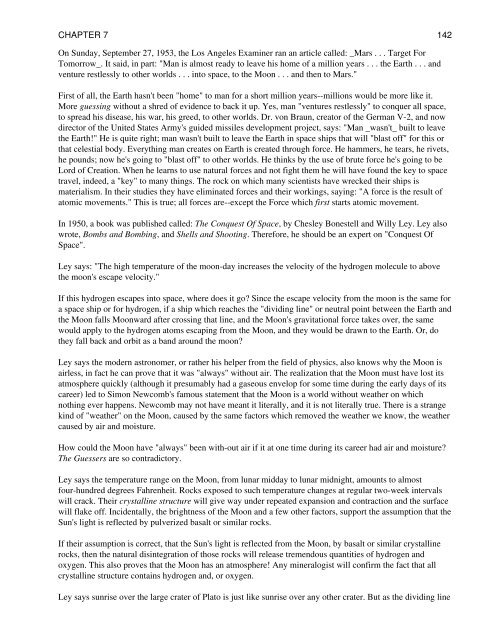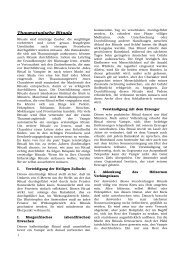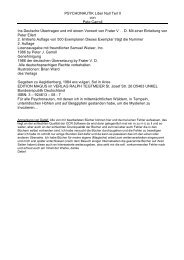CHAPTER 2 CHAPTER 3 CHAPTER 1 CHAPTER 2 CHAPTER 3 ...
CHAPTER 2 CHAPTER 3 CHAPTER 1 CHAPTER 2 CHAPTER 3 ...
CHAPTER 2 CHAPTER 3 CHAPTER 1 CHAPTER 2 CHAPTER 3 ...
You also want an ePaper? Increase the reach of your titles
YUMPU automatically turns print PDFs into web optimized ePapers that Google loves.
<strong>CHAPTER</strong> 7 142<br />
On Sunday, September 27, 1953, the Los Angeles Examiner ran an article called: _Mars . . . Target For<br />
Tomorrow_. It said, in part: "Man is almost ready to leave his home of a million years . . . the Earth . . . and<br />
venture restlessly to other worlds . . . into space, to the Moon . . . and then to Mars."<br />
First of all, the Earth hasn't been "home" to man for a short million years--millions would be more like it.<br />
More guessing without a shred of evidence to back it up. Yes, man "ventures restlessly" to conquer all space,<br />
to spread his disease, his war, his greed, to other worlds. Dr. von Braun, creator of the German V-2, and now<br />
director of the United States Army's guided missiles development project, says: "Man _wasn't_ built to leave<br />
the Earth!" He is quite right; man wasn't built to leave the Earth in space ships that will "blast off" for this or<br />
that celestial body. Everything man creates on Earth is created through force. He hammers, he tears, he rivets,<br />
he pounds; now he's going to "blast off" to other worlds. He thinks by the use of brute force he's going to be<br />
Lord of Creation. When he learns to use natural forces and not fight them he will have found the key to space<br />
travel, indeed, a "key" to many things. The rock on which many scientists have wrecked their ships is<br />
materialism. In their studies they have eliminated forces and their workings, saying: "A force is the result of<br />
atomic movements." This is true; all forces are--except the Force which first starts atomic movement.<br />
In 1950, a book was published called: The Conquest Of Space, by Chesley Bonestell and Willy Ley. Ley also<br />
wrote, Bombs and Bombing, and Shells and Shooting. Therefore, he should be an expert on "Conquest Of<br />
Space".<br />
Ley says: "The high temperature of the moon-day increases the velocity of the hydrogen molecule to above<br />
the moon's escape velocity."<br />
If this hydrogen escapes into space, where does it go? Since the escape velocity from the moon is the same for<br />
a space ship or for hydrogen, if a ship which reaches the "dividing line" or neutral point between the Earth and<br />
the Moon falls Moonward after crossing that line, and the Moon's gravitational force takes over, the same<br />
would apply to the hydrogen atoms escaping from the Moon, and they would be drawn to the Earth. Or, do<br />
they fall back and orbit as a band around the moon?<br />
Ley says the modern astronomer, or rather his helper from the field of physics, also knows why the Moon is<br />
airless, in fact he can prove that it was "always" without air. The realization that the Moon must have lost its<br />
atmosphere quickly (although it presumably had a gaseous envelop for some time during the early days of its<br />
career) led to Simon Newcomb's famous statement that the Moon is a world without weather on which<br />
nothing ever happens. Newcomb may not have meant it literally, and it is not literally true. There is a strange<br />
kind of "weather" on the Moon, caused by the same factors which removed the weather we know, the weather<br />
caused by air and moisture.<br />
How could the Moon have "always" been with-out air if it at one time during its career had air and moisture?<br />
The Guessers are so contradictory.<br />
Ley says the temperature range on the Moon, from lunar midday to lunar midnight, amounts to almost<br />
four-hundred degrees Fahrenheit. Rocks exposed to such temperature changes at regular two-week intervals<br />
will crack. Their crystalline structure will give way under repeated expansion and contraction and the surface<br />
will flake off. Incidentally, the brightness of the Moon and a few other factors, support the assumption that the<br />
Sun's light is reflected by pulverized basalt or similar rocks.<br />
If their assumption is correct, that the Sun's light is reflected from the Moon, by basalt or similar crystalline<br />
rocks, then the natural disintegration of those rocks will release tremendous quantities of hydrogen and<br />
oxygen. This also proves that the Moon has an atmosphere! Any mineralogist will confirm the fact that all<br />
crystalline structure contains hydrogen and, or oxygen.<br />
Ley says sunrise over the large crater of Plato is just like sunrise over any other crater. But as the dividing line






